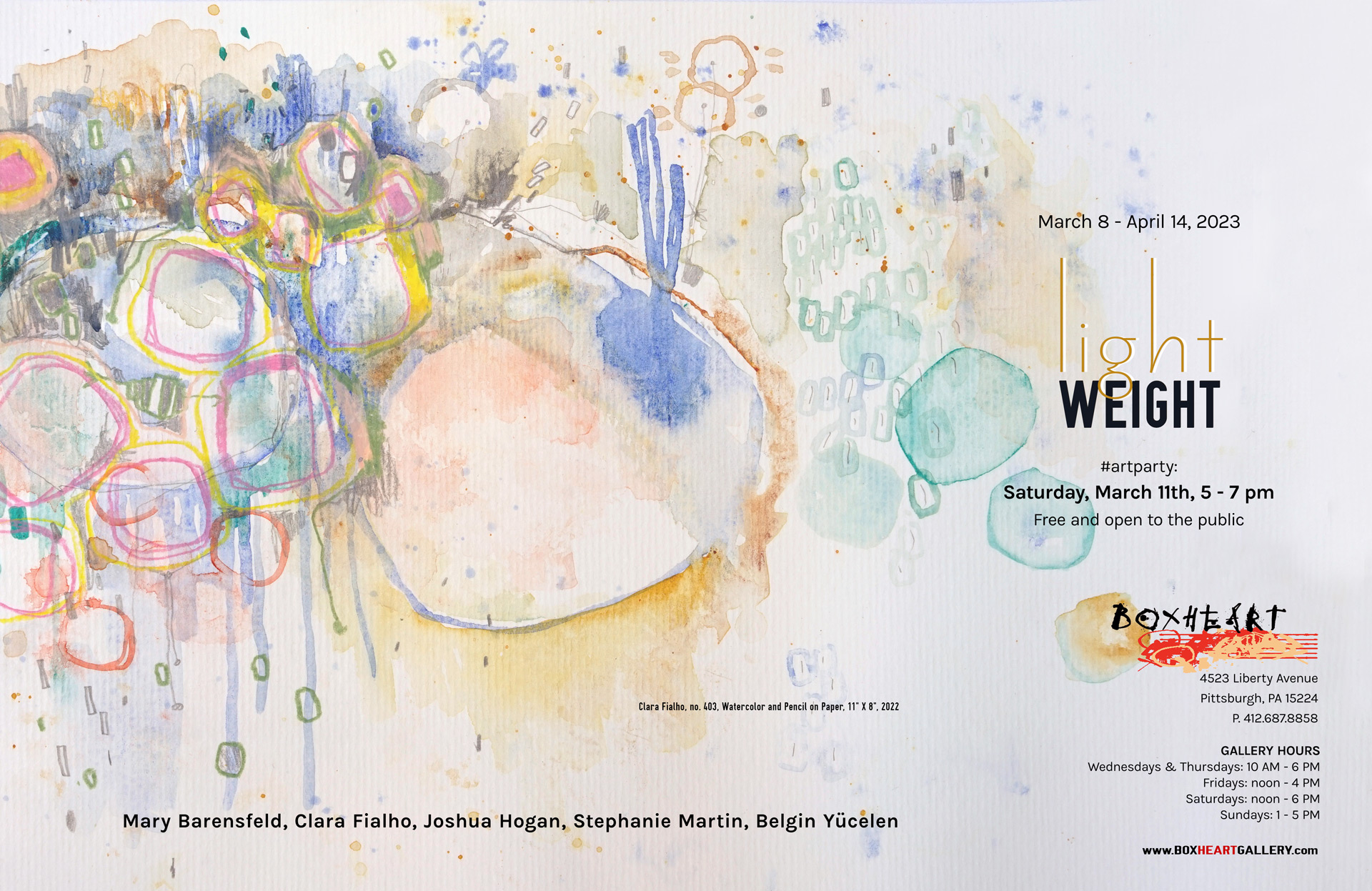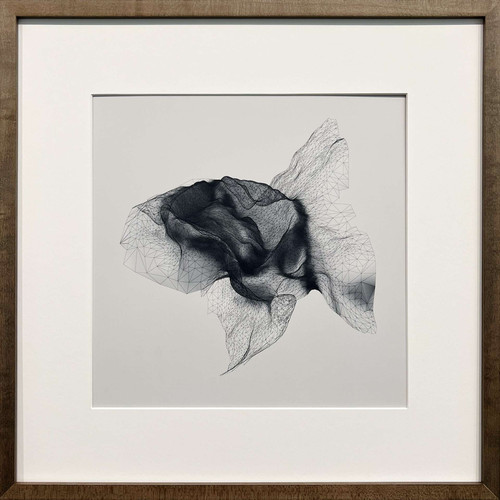Light Weight
In Physics there is a paradox when discussing the weight of light. Light, which is composed of protons, has no mass and can’t weigh anything. However, Albert Einstein taught us that light carries momentum in the form of energy. His equation, E = mc2, revealed that mass and energy are different forms of the same thing.
Throughout history artists have studied, implemented, and incorporated light in their artwork. Caravaggio used the chiaroscuro technique, transfixing subjects in bright shafts of light and darkening shadows. This technique created such a dramatic effect that the viewer was immersed into the visceral visual weight of his subject. Leonardo da Vinci had a more methodical and scientific relationship with light. He studied and observed optics and astronomy to understand light, while considering a “realization of the eye’s propensity for deception”. He stated that “no substance can be comprehended without light and shade” and that, “light and shade are caused by light!” Da Vinci’s persistence led to some of the most elaborate and accurate portrayals of reflection, shadow, and luminescence to this day. Other artists were more obsessed with the changing effects of light. Claude Monet painted the same landscape at varies hours of the day to capture how light shapes, forms, and shifts subjects. Unlike Caravaggio and da Vinci, Monet’s paintings portray light as energy. Light's momentum defines the landscape.
As a tool, light creates form, emotion, momentum, balance, and accuracy. Light elicits dramatic movement, allows sparse space, or achieves illustrative accuracy. Light is integral in the elements of color, saturation, hue, and contrast. The artistic process is rooted in the understanding of light and the use of light to create weight. Whether composing a visual weight to attract the viewer’s eye, or an intrinsic weight that contributes to the viewer’s experience, the interpretation of Light and Weight in art is a fascinating interaction. The weight of art is energy.
For Joshua Hogan’s exhibit Light Weight, he wanted to include artwork by artists that not only inspire him but also have unique interpretations of light and weight in their art. He’s honored to exhibit his paintings alongside artwork by Mary Barensfeld, Clara Fialho, Stephanie Martin, and Belgin Yücelen.

MARY BARENSFELD - Mary Barensfeld seeks to blur the lines between architecture, landscape architecture, structure, and art. Utilizing a design process melding hand modeling, sketching, and drawing with computer modeling, digital fabrication and animation, her work dives into structural integrity as honest indicator of force and microscopic structure. Historic and natural site-specific parameters influence her studies in geometry-based systems thinking and fabrication innovation. Barensfeld, a licensed architect, spent twelve years in San Francisco, California, working on architecture, landscape, and engineering projects. This period of interdisciplinary study ignited a desire to seek a continuous synthesis of structure, topography, and form. Her award-winning and internationally published design firm, founded in 2013 and now based in Pittsburgh, PA, has landscape and architecture work built in both California and Pennsylvania. The firm’s mantra: Architecture does not stop with the building. Architecture and landscape should meld into one design process.
CLARA FIALHO - In her abstract paintings, Clara Fialho explores the relationship between form and color to illustrate theoretical concepts and spaces. Fialho works with different types of painting and drawing implements, combining pigments, shapes, and textures in compositions of various sizes. Influenced by surrealism, she considers color and form as tools that map invisible forces and realms. Fialho describes the major themes of her artwork as the “unconscious, impermanence, relationships, unity, the universe, nature, dreams, and love.” Fialho (American, b. Brazil, 1984) is a New York-based artist. She received her BFA from the Cooper Union on a full merit scholarship and had her first solo exhibition in Chelsea at age 22. Since then, she has been exhibiting extensively throughout the country and abroad. Her artwork has been featured in numerous publications, including the New York Times and the cover of New York Spaces Magazine.
JOSHUA HOGAN - With a reality most akin to the Surrealists, Joshua Hogan’s painted shapes are a complex web of random exchanges that lie in the unconscious and its disruptive disconnection of signified relations. His paintings are an allegory for the interactions he experiences and the relationships between people in his own personal story. The act of painting requires the letting go of perceived memory in exchange for the opportunity to see something new. Painting is how he interprets the stories running through his mind that affect, form, and reshape his own sense-of-self. The atmospheric shifts of color in his paintings introduce a new spectrum to the visible world and describe what it might look like to see through this world. Hogan embraces the fact that interactions between us are now also defined by the meeting of our projected selves. Although, it is often a troubling experience, he attempts to imagine and capture what it just might look like in this internet of things, all-at-once luminous space and data-space.
STEPHANIE MARTIN - Stephanie Martin is an interdisciplinary artist who creates biomorphic expressionistic forms using ink and low fire ceramics. The forms represent new worlds that range from a cellular level to a macroscopic planetary scale. The fabricated ecosystems are a representation of her perceptions and experiences of life; familiar to Earth, and yet an entirely new place. As an abstract reflection of biological forms within alternating scales, Martin's artwork focuses on the duality present in life, and utilizes comparisons of attraction and repulsion. The overall processes involved are a significant part of her artistic process, as they function as a way to express and reflect on personal experiences. Martin received a Masters of Art and a BS in Art Education, at Indiana University of Pennsylvania in Indiana, PA. Her artwork was recently exhibited in Counterpressures, Forum Gallery, at the Carnegie Museum of Art and the Associated Artists of Pittsburgh’s 107th Annual Exhibition, Cantilever Gallery and the Arts Center at the Westmoreland Museum of American Art.
BELGIN YüCELEN creates imaginary worlds that help conjure unrealized possibilities. While enhancing our imaginations and consciousness, Yücelen’s art remains true to the desire to create meaning and beauty in subtle simplicity. With her installations, sculptures, films and prints, she asks the questions of Who we are? and Where we are going? Rather than a direct representation, she creates a fictional world beyond the existing to conjure unrealized possibilities to challenge imaginations. Traces of her previous years in Turkey appear in her artwork placing it at the fascinating edge where East and West meet and ancient and modern coincide. She has been recognized by organizations such as the Colorado Creative Industries, Boulder Country Arts Alliance, Moon and Stars Project Grant, Clark Hulings Fund, Hemera Foundation, and National Sculpture Society. She founded House of Serein in 2019 as a creative space for community use and studios for artists in Boulder, CO. She is currently serving as a board member at the Dairy Arts Center and as a grant panelist at the Boulder Arts Commission.
![]() View images from the exhibition Light Weight, which was on exhibit March 8th through April 14th, 2023.
View images from the exhibition Light Weight, which was on exhibit March 8th through April 14th, 2023.












